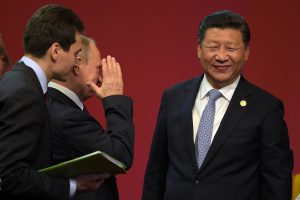
Robert Daly January 19, 2017
Each weekday morning, I cross D.C.’s National Mall and pass a sign on Constitution Avenue bearing an epigram by the U.S. architect Daniel Burnham: Make No Little Plans. Little plans, Burnham warned, have “no magic to stir men’s blood,” so we must “make big plans; aim high in hope and work,” and “remember that our sons and our grandsons are going to do things that would stagger us.”
And every morning, these words make me think not of Burnham’s 20th century United States, but of 21st century China. That is now where staggering plans are made and funded. Some Chinese plans will improve lives around the world, while others may erode the liberal international order the United States has led since 1945.
By 2016, a broad swathe of Americans had begun to feel the effects of China’s development in their everyday lives—in shopping malls, at the multiplex, in paychecks—and to sense that the center of global power might be shifting from the United States toward China. Since the two countries established relations in 1979, U.S. institutional and ideational impact on China has far outstripped China’s minuscule influence on U.S. tastes and values. In 2016, China’s big plans may have begun to tilt the balance. Consider the summer of 2016: In June, China built the world’s fastest supercomputer (unlike the previous fastest machine, also made in China, the new one used only Chinese chips—and no U.S. hardware); in July, China completed the world’s biggest radio telescope; and in August, it sent the world’s first quantum-communications satellite into orbit.
China’s 2016 successes followed its construction of the world’s longest high-speed rail network; its creation, over the last few decades, of cities, like Pudong and Shenzhen, out of rice paddies; and its development of the world’s largest telecom system. It is now China, not the United States, that uses industrial policy to master emerging technologies, makes massive capital investments, appropriates land, and quickly brings new ideas to market on a continental scale. China increasingly drives global supply and demand, while the West settles for Nobel prizes.
China’s ability to plan big depends in part on foreign innovation, some of it stolen, and on an authoritarian government that botches many of its grand projects. But that will be scant consolation for Americans if the next wave of discovery, not to mention both the hard and soft power accrued by it, is spurred by Chinese telescopes and satellites. China, furthermore, is aware of its creativity deficit. In 2016, Beijing accelerated its Silicon Valley shopping spree, buying tech and talent it couldn’t produce at home. Americans often observe that China is imitative, not innovative, and that its politicized universities and denial of personal freedom make it dependent on others for new ideas. That may have been important before China got rich, but does China’s inability to foster innovation still matter now that it can purchase it overseas?
China’s big plans don’t stop at its borders. Beijing intends to lead the integration, through infrastructure, of Eurasia and Africa. (On January 1, the first China-United Kingdom freight train set off from the city of Yiwu.)
If China builds the infrastructure that binds and enriches the world’s non-American nations, most of which already count China as their top trading partner, the United States will be a bystander to one of the century’s great transformations. The United States offers developing nations sermons on democracy; China builds their airports, harbors, and highways. Which approach will garner greater influence? As David Lampton, author of The Three Faces of Chinese Power, has said, “put your money on money.”While the scope of Beijing’s investments is staggering, the purchasing power of Chinese consumers may prove more influential yet. Credit Suisse estimates that, since 2015, China has had a larger middle class (people with U.S.$50,000-500,000 in annual income) than the United States. That means China will be tastemaker to the world. Products will be designed to satisfy Chinese consumers and Chinese Communist Party (C.C.P.) regulations. Some cell phones sold in the United States are already built to Chinese specifications. Hollywood studios, aware that China may soon offer the world’s biggest box office, rewrite scripts to ensure U.S. movies play on Chinese screens. These erstwhile architects of U.S. soft power have given the C.C.P. a channel for the export of censorship.
What’s At Stake?
Barring a domestic economic or political collapse—both unlikely—China is destined to be the world’s largest market for most products and commodities, the top issuer of everything from Ph.D.s and patents to greenhouse gases, and a leading shaper of global norms and institutions. There is nothing nefarious in this; it’s just the law of large numbers. When hundreds of millions of people in the same country get rich fast, that country’s power increases. In broad terms, China is doing what other rising powers, including the United States, have done: using financial and military power to shape the external environment to its aims.
It is those aims, not Chinese power per se, that should concern China’s neighbors and the United States.
The C.C.P.’s primary goal is maintaining its monopoly on power. China’s military strategy, trade and investment policy, global media, and cultural and educational exchanges all serve that end. Because the C.C.P. feels constrained and demonized by the modern liberal order, it uses its economic and military might to break constraints and change minds. Beijing is trying to persuade the world to accept the C.C.P.’s domestic standards for the treatment of individuals, information, and institutions as legitimate alternatives to liberal norms. This program is evident in China’s rejection of international law in the South China Sea, its gaming of international trade rules, its curbing of Internet freedoms in the name of “cyber security,” its attempts to weaken NGOs in China and at the United Nations (U.N.), and in its readiness to punish nations which host the Dalai Lama or celebrate Chinese dissidents on their own soil. China pushes these policies even as it provides a growing number of public goods, including U.N. peacekeeping, disaster relief, medical aid, and badly needed infrastructure investment. For the C.C.P., there is no contradiction between the illiberal and beneficial aspects of its foreign policy: protectionist authoritarianism provides the stability that makes Chinese generosity and trade possible. All of these variables should be understood and welcomed, in Beijing’s view, as essential parts of a balanced equation.
The question posed by China’s drive to shape world order is, do we wish to live in a world that is increasingly amenable to an increasingly repressive C.C.P.? What range of compromise to liberal principles should we accept to secure peace, accrue wealth, and develop technology in a world in which China is one of the dominant powers?
Twilight of the Engagement Consensus
China’s growing influence; the policies of General Secretary Xi Jinping, who sees Western values as an existential threat to his state; and Chinese assertiveness in the Western Pacific have convinced many Americans that the policy of engaging China has failed. Engagement, pursued by all American presidents since 1979, has been based on recognition that U.S.-China relations are both cooperative and competitive, and on the belief that encouraging cooperation is the United States’ best means of convincing China to support the liberal international order.
China has supported global norms more often than not over the past three decades, but under Xi, China seems determined—gradually and peacefully, if possible, and through coercion if necessary—to become the benign hegemon of Asia. China can only achieve this through the weakening of the United States’ alliance system and rejection of key principles of international law.
Against this background, a growing number of U.S. analysts, and several of Donald Trump’s advisors, argue that, through engagement, the United States has naively raised a tiger that devours U.S. prosperity. U.S. policy should therefore be guided by clear recognition that relations with China are, in essence, strategically, economically, and ideologically competitive. We should cooperate where we can, but steel ourselves to compete when we must.
2017: Rebalance Redux
When Donald Trump takes the oath of office on January 20, Chinese leaders and citizens will pay closer attention than they have to any prior inauguration. His campaign rhetoric, tweets, and appointments suggest Trump is eager to launch a competitive era in U.S.-China relations. China is less keen on adversarial relations. Its continued development requires a peaceful external environment and access to the American market. Because China has more to lose from heightened competition than the U.S., it will meet any Trumpian onslaught with the full attention of its government and military and will mobilize industry, media, and public opinion as only authoritarian regimes can. President Trump, meanwhile, cannot possibly make competition with China his top priority. His administration will be too busy and distracted, domestically and internationally, to pay the strategic attention to China that his China rhetoric has implied. The new president will therefore have to refine his competitive instincts in light of the complexity, ambiguity, and high risk which remain baseline facts of Sino-U.S. relations.
President Trump will also have to deal with the fact of limited resources. Early in its tenure, his team must review its global policy priorities and conduct an audit of America’s finances and will. If its assessments are thorough and objective, the administration is bound to find that China’s increased power, U.S. commitments in the Middle East and Europe, the domestic budget crisis, and the need to rebuild the U.S.’s job base and infrastructure—all while cutting taxes—mean that the U.S. cannot sustain the type of primacy to which it is accustomed in the Western Pacific. The Trump administration will have no choice but to rely on allies and partners, trade, diplomacy, and soft power to achieve its aims in the region. Sooner or later, and the sooner the better, Trump is bound to rediscover the strategic rationale for the Rebalance to Asia.
Whether or not Trump’s pledge to build a 350-ship navy is realistic, it signals his acceptance of the need for a military rebalance; the only threat that might justify such expense is China’s challenge to U.S. preeminence. A military buildup alone, however, will not convince Asian nations that the United States can check China’s power over the long haul. To compete in a region that boasts 60 percent of the world’s consumers and roughly two-thirds of global economic growth, the United States must set trade standards that benefit Asia as well as American companies and consumers. That means the Trump administration will have to resurrect the economic rebalance in some form, despite the death of the Trans-Pacific Partnership. Coordinating the security and prosperity legs of competition with China, moreover, will require U.S. participation in the growing number of organizations, treaties, and financial institutions that are reshaping Asia. Diplomatic rebalancing must therefore be added to the mix.
That completes the equation: military + economic + diplomatic focus on Asia was precisely the formula for the rebalance announced by Obama in 2012.
President Trump will not replay the Obama rebalance; he will reinvent it on a more militarized and moralistic basis. To convince a skeptical electorate to pay for an expanded military, Trump will likely invoke an issue he has shown no interest in to date: human rights. After all, the primary reason that the U.S. (and much of the rest of the world) should be wary of China’s wealth and power is that they come packaged with political practices that are noxious to free nations—practices that grow more severe as Xi tightens his control over Chinese society. Under Xi, China is “going bad,” as the journalist James Fallows put it in the December 2016 issue of The Atlantic. Fallows cautioned that “by ‘bad’ I don’t mean morally,” but that is exactly what he means. Trump is sure to seize on that “badness” eventually to make his case to taxpayers, and his penchant for moral critiques—“crooked,”China’s “rape” of the American economy—indicates that once he gets warmed up, he will attack China’s human rights record with gusto.
Re-Engagement
Even as it pursues its rebalance, the Trump administration will discover that it cannot isolate China. China has so much to offer the world (see money, above) that Trump will find little international support for policies aimed at stanching its economic development. Obama’s disastrous opposition to the China-led Asian Infrastructure Investment Bank demonstrated that even the United States’ closest allies will not join in unreasonable opposition to China. The U.S. and China are now so interdependent, moreover, that Washington cannot impose economic costs on China that don’t ricochet onto U.S. allies and the United States itself.
Faced with the fact (facts keep cropping up) of mutual dependence, the Trump team will realize that, just as it has no choice but to reclaim the rebalance, it cannot abandon engagement altogether.
Only by engaging can the United States continue to benefit from the talent and energy of the one-fifth of humanity that resides in China, and only through engagement, coordinated with military, economic, and diplomatic strength, can the United States continue to catalyze change in a China that can still be influenced by American policy and American examples.He may not adopt the terms engagement and rebalance, but President-elect Trump is fortunate that these policies provide a rough roadmap for managing U.S.-China relations, even in an era of heightened competition. The aim of Trumpian Rebalance and Engagement should be to convince Beijing that, while a risen China is welcome as a leading provider of public goods and contributor to global norms, the United States and its allies are determined to prevent an illiberal China from dominating Asia.
That’s a Big Plan that Daniel Burnham might applaud. Realizing it will require the hard work of decades. The alternative is a new Cold War—one that renders all talk of global norms obsolete.
– See more at: http://www.chinafile.com/viewpoint/do-we-want-live-chinas-world#sthash.14zijlJJ.dpuf



